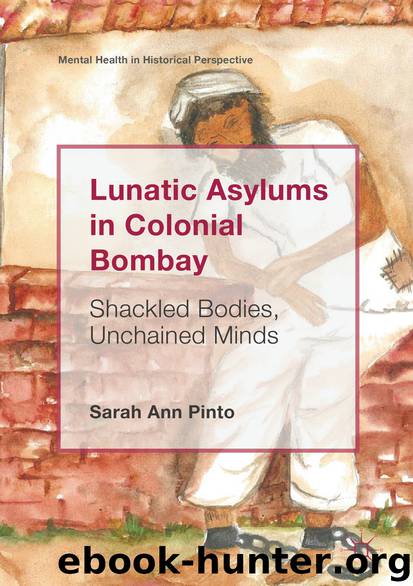Lunatic Asylums in Colonial Bombay by Sarah Ann Pinto

Author:Sarah Ann Pinto
Language: eng
Format: epub
ISBN: 9783319942445
Publisher: Springer International Publishing
Superintendents regularly used the stomach pump on patients who ‘obstinately’90 refused food in the asylum, despite the dangers it involved. As Surgeon Gillanders noted: ‘Its repeated use is highly dangerous and even in the first application … had the man, made violent resistance it might have occasioned death’.91 Apart from the stomach pump, staff also used other methods, such as injecting food through the patient’s rectum, as in the case of one Parsi patient, whom asylum staff injected with beef tea in this manner. After all attempts to feed him failed, they discharged the Parsi patient after one month. His relatives reported that within a few days of his return, he began to consume food voluntarily. Superintendent Niven concluded that the willingness of the patient to eat was a sign of his recovery.92
Doctors interpreted appropriate consumption as a sign of recovery in patients. Sheik Curim, a patient at the Colaba Lunatic Asylum, when admitted in 1814, ate little and ‘seldom with seeming relish’. Each month the superintendent recorded his appetite and explained any improvement in appetite as an indication of recovery in his mental health.93 In 1874, Superintendent Niven reported a case of food refusal of a Parsi who he treated with a stomach pump for two months. Finally, ‘one day he was accidentally given a beer, which had the desired effect, as he began to eat soon after on his own accord, and became stout and strong and shows signs of improvement’.94 Patient appetites were not only monitored but also manipulated. Conformity of Indian patients’ appetites to set asylum standards became an indication of their recovery. While setting standards for appropriate consumption, the policy on asylum diet distribution had several contradictions.
Diet distribution reflected pretentious attitudes on the part of asylum authorities. Asylum reports described patient diets as ‘liberal’, yet ‘the greatest economy and supervision’ was maintained ‘in the regulation and distribution of food’.95 While superintendents reported the liberality, variety, and generosity of asylum food, they based their assumption of the sufficiency of food for patients, on what they believed patients would have received in their own homes. They claimed that ‘the diet of patients leaves nothing to be desired’ and that they were ‘infinitely better and more liberally fed than their relatives at home’. Furthermore, ‘Their diet [was] changed daily, well cooked and properly served’.96 The Hyderabad Lunatic Asylum only provided two main meals; breakfast at 8 am, dinner at 1.30 pm, and supper at 6–6.30 pm.97 The sufficiency of the quantity of food was justified by the superintendents by stating that no patients had complained.98 In order to curtail expenditure, diets were often limited and constrained. For the years 1871–1872, the total expenditure on food for patients in the Presidency was Rs. 40,993; in the following year, the amount reduced to Rs. 29,073, and by 1873–1874 the dietary charges for the asylums of the Presidency stood at Rs. 20,613. The Presidency asylums made a saving of Rs. 19,695 in a short span of three years, ‘not withstanding an increase in the number of lunatics’.
Download
This site does not store any files on its server. We only index and link to content provided by other sites. Please contact the content providers to delete copyright contents if any and email us, we'll remove relevant links or contents immediately.
| Africa | Americas |
| Arctic & Antarctica | Asia |
| Australia & Oceania | Europe |
| Middle East | Russia |
| United States | World |
| Ancient Civilizations | Military |
| Historical Study & Educational Resources |
Underground: A Human History of the Worlds Beneath Our Feet by Will Hunt(12022)
Sapiens by Yuval Noah Harari(5293)
Navigation and Map Reading by K Andrew(5111)
The Sympathizer by Viet Thanh Nguyen(4305)
Barron's AP Biology by Goldberg M.S. Deborah T(4096)
5 Steps to a 5 AP U.S. History, 2010-2011 Edition (5 Steps to a 5 on the Advanced Placement Examinations Series) by Armstrong Stephen(3687)
Three Women by Lisa Taddeo(3354)
Water by Ian Miller(3127)
The Comedians: Drunks, Thieves, Scoundrels, and the History of American Comedy by Nesteroff Kliph(3039)
Drugs Unlimited by Mike Power(2545)
A Short History of Drunkenness by Forsyth Mark(2233)
DarkMarket by Misha Glenny(2158)
The House of Government by Slezkine Yuri(2158)
And the Band Played On by Randy Shilts(2129)
The Library Book by Susan Orlean(2042)
Revived (Cat Patrick) by Cat Patrick(1963)
The Woman Who Smashed Codes by Jason Fagone(1929)
Birth by Tina Cassidy(1864)
The Absolutely True Diary of a Part-Time Indian by Sherman Alexie(1857)
